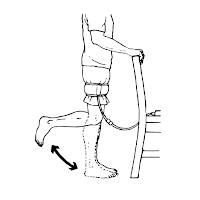



 KAATSU 3-point Exercises are a fundamental part of the standard KAATSU protocol for both the arms and legs.
KAATSU 3-point Exercises are a fundamental part of the standard KAATSU protocol for both the arms and legs. Dr. Yoshiaki Sato, who invented KAATSU in 1966, first established the KAATSU 3-point Exercises in the 1970s. These simple exercises have been performed safely and effectively among millions of individual KAATSU sessions among people of all ages and abilities with myriad physical conditions or ailments.
The KAATSU 3-point Exercises can either be used to help determine the optimal SKU pressure or as a form of basic exercise for both the arms and legs. After the Base SKU (manually applied pressure) is established, then the KAATSU 3-point Exercises is a means to determine if the Optimal SKU (inflated pressure of the pneumatic bands) is appropriate (read a more detailed explanation here).
Alternatively, especially for Baby Boomers and adults who are being reconditioned back to a state of wellness through a simple exercise program, the KAATSU 3-point Exercises can consist of their entire KAATSU training program. When the KAATSU 3-point Exercises are performed, the exercises can be performed either on a KAATSU Master or a KAATSU Nano or a KAATSU Cycle unit. The KAATSU 3-point Exercises can be performed while the user is either tethered (connected) or untethered (disconnected) to the units.
KAATSU Leg 3-point Exercises [illustrations posted on left]
The KAATSU 3-point Exercises for the legs are either defined as Standard or Advanced.
The Standard KAATSU 3-point Exercises for the legs involves toe curls, toe raises, and heel raises. These are all performed while the user is seated comfortably with good posture on a chair. In general, these are preferred for older or less fit individuals or those just starting an exercise program or KAATSU.
The Advanced KAATSU 3-point Exercises for the legs are alternatively used by more fit or active individuals or for those individuals with more experience in KAATSU. These 3 basic exercises includes heel raises, leg curls and squats. The heel raises can be done while sitting or standing. The leg curls can be performed while standing and holding onto a chair or balancing against a wall. The squats (or "chair touches") can be performed while bending the knees to touch a chair and then popping back up.
Ideally, the squats are "non-lock" (partial extension) so that the muscles are constantly engaged and there is no rest while the knees are "locked" straight (in a full extension). This will build up fatigue and lactic acid more quickly.
Each set of exercises should be done 3-4 times each with a maximum of 20 seconds between each set. Ideally, the number of repetitions for each exercise decreases before the user reaches muscular or technical failure (or fatigues).
That is, an ideal set would be 25-30 repetitions on set #1, 10-15 repetitions on set #2, and 5-10 repetitions on set #3. Even if only 1-2 repetitions are completed on the last set, this failure signal sent to the central nervous system is one of the goals of KAATSU.
KAATSU Arm 3-point Exercises [illustrations posted here]
The KAATSU 3-point Exercises for the arms involves hand clenches, bicep curls and tricep extensions. Each set of exercises is done 3 times each with a maximum of 20 seconds rest between each set. Ideally, the number of repetitions for each exercise decreases before the user reaches muscular or technical failure*.
That is, an ideal set would be 25-30 repetitions on set #1, 10-15 repetitions on set #2, and 5-10 repetitions on set #3. Even if only 1-2 repetitions are completed on the last set, this failure signal sent to the central nervous system is one of the goals of KAATSU.
* Technical failure is defined when the individual starts to do improper technique (movement) due to an increasing sense of fatigue. At this point, the set is stopped.
Copyright © 2014 - 2015 by KAATSU Global
No comments:
Post a Comment